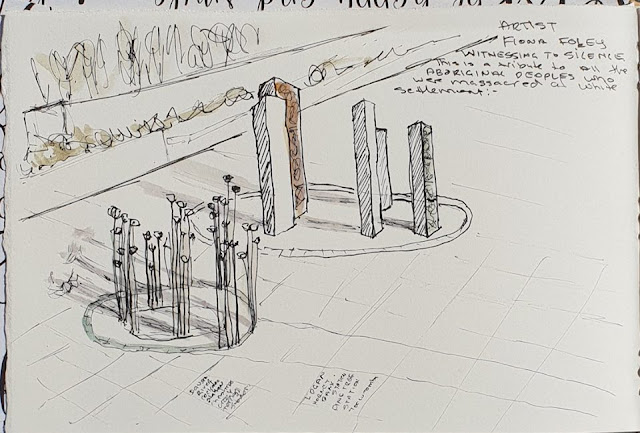Today, I sketched with the Brisbane City Sketchers at the Queensland Supreme Courts Precinct. There were three of us today, braving the sharp cool wind, enjoying the sunshine, and thanking our lucky stars that the Coffee Club had their heaters going.
I started a new sketchbook today, one gifted to me by my friend Liane. It is 90lb paper maybe a little lighter even, 8.5" x 6"
This three-storied brick department store building was erected in
several stages between 1912 and 1963, for the Brisbane firm of McDonnell
& East Ltd. McDonnell & East Ltd were established as a firm of
importers, cash drapers, tailors, outfitters, dressmakers and milliners.
About 1908, Jack McDonnell and Fraser and Harry East, sons of the
founders, entered the firm.
The George Street Post Office was located in the McDonnell & East Ltd building from 27 July 1931 until 28 September 1990
In late 2005, the building was bought by De Martini and John Fletcher Properties Group and Rohrig Constructions for $8.38 million. It was redeveloped with retail spaces fronting George Street and Tank Street, and office space throughout the remainder of the building.
The George Street Post Office was located in the McDonnell & East Ltd building from 27 July 1931 until 28 September 1990
In late 2005, the building was bought by De Martini and John Fletcher Properties Group and Rohrig Constructions for $8.38 million. It was redeveloped with retail spaces fronting George Street and Tank Street, and office space throughout the remainder of the building.
Fiona Foley Witnessing to Silence 2004
The installation consists of a water feature of cast bronze lotus lilies, stainless steel columns embedded with ash in laminated glass, and etched place names in granite pavers. During the planning phases Foley intimated that the work referred to Australian bush fires and floods. Once the work was in place, however, she revealed to The Australian that this piece was actually a memorial to the many massacres of Aboriginal people which had taken place, during the colonial settlement and expansion of Queensland in the early 19th Century. There are names engraved in paver, 94 names, that are the places of the massacres.
A trenchant critic of colonial policies and practices, Foley employs a number of artistic strategies to convey her political themes.
Witnessing to Silence as a public installation acts as a memorial to those massacred in the state of Queensland. Remnants of cultural practice are also suggested through the use of symbols. The element of fire and water belie the common practice of covering up the evidence by getting rid of the bodies.
The installation consists of a water feature of cast bronze lotus lilies, stainless steel columns embedded with ash in laminated glass, and etched place names in granite pavers. During the planning phases Foley intimated that the work referred to Australian bush fires and floods. Once the work was in place, however, she revealed to The Australian that this piece was actually a memorial to the many massacres of Aboriginal people which had taken place, during the colonial settlement and expansion of Queensland in the early 19th Century. There are names engraved in paver, 94 names, that are the places of the massacres.
A trenchant critic of colonial policies and practices, Foley employs a number of artistic strategies to convey her political themes.
Witnessing to Silence as a public installation acts as a memorial to those massacred in the state of Queensland. Remnants of cultural practice are also suggested through the use of symbols. The element of fire and water belie the common practice of covering up the evidence by getting rid of the bodies.








No comments:
Post a Comment